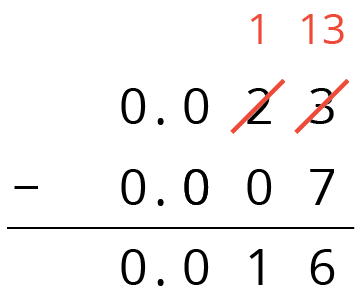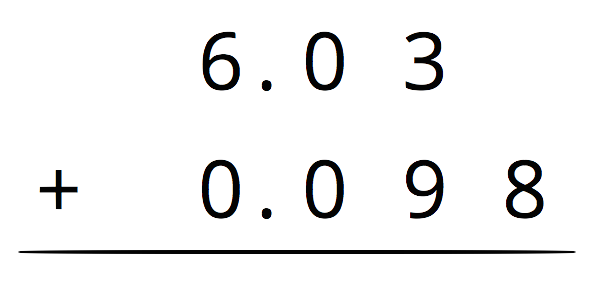Lesson 14
Using Diagrams to Represent Addition and Subtraction
14.1: Do the Zeros Matter?
-
Evaluate mentally: \(1.009+0.391\)
-
Decide if each equation is true or false. Be prepared to explain your reasoning.
- \(34.56000 = 34.56\)
- \(25 = 25.0\)
- \(2.405 = 2.45\)
14.2: Finding Sums in Different Ways
-
Here are two ways to calculate the value of \(0.26 + 0.07\). In the diagram, each rectangle represents 0.1 and each square represents 0.01.
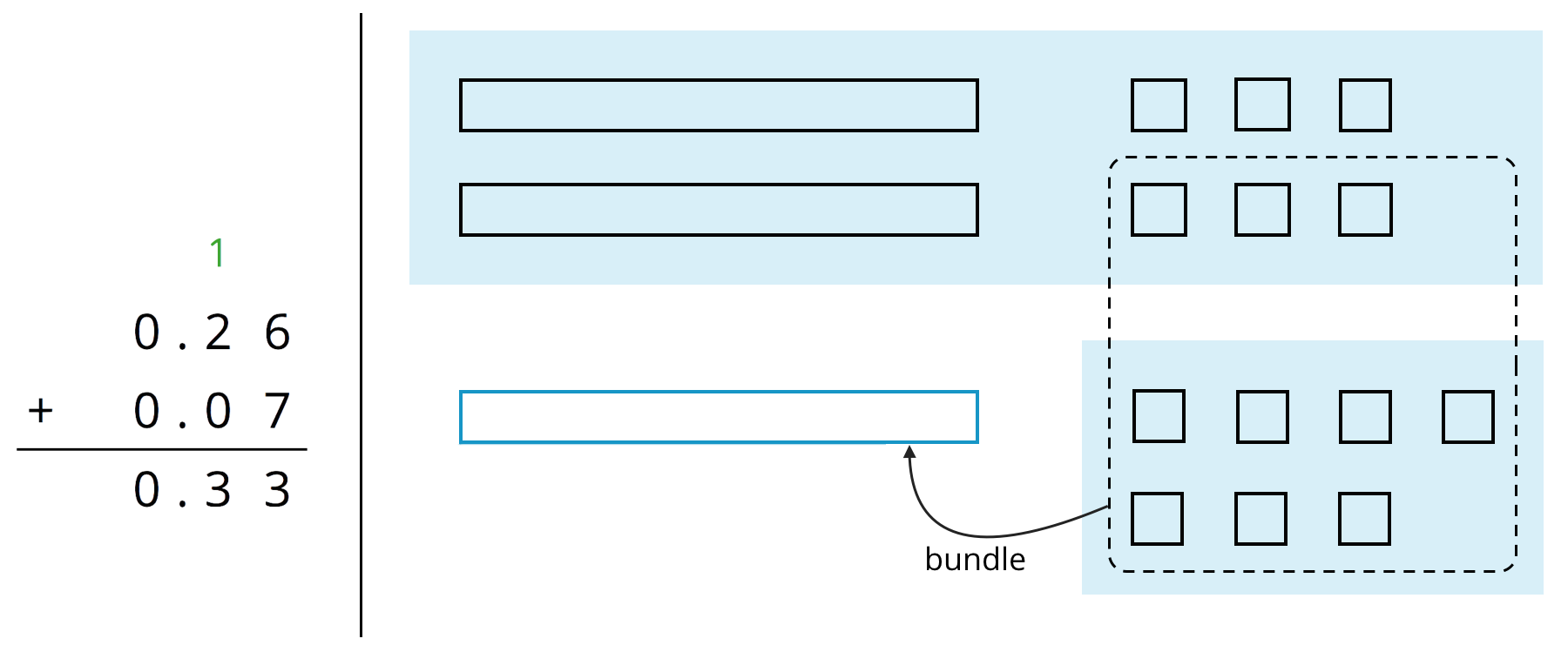
Use what you know about base-ten units and addition of base-ten numbers to explain:
-
Why ten squares can be “bundled” into a rectangle.
-
How this “bundling” is reflected in the computation.
The applet has tools that create each of the base-ten blocks. Select a Block tool, and then click on the screen to place it.

One

Tenth

Hundredth
Click on the Move tool when you are done choosing blocks.

-
-
Find the value of \(0.38 + 0.69\) by drawing a diagram. Can you find the sum without bundling? Would it be useful to bundle some pieces? Explain your reasoning.
-
Calculate \(0.38 + 0.69\). Check your calculation against your diagram in the previous question.
-
Find each sum. The larger square represents 1, the rectangle represents 0.1, and the smaller square represents 0.01.
-
A distant, magical land uses jewels for their bartering system. The jewels are valued and ranked in order of their rarity. Each jewel is worth 3 times the jewel immediately below it in the ranking. The ranking is red, orange, yellow, green, blue, indigo, and violet. So a red jewel is worth 3 orange jewels, a green jewel is worth 3 blue jewels, and so on.
-
If you had 500 violet jewels and wanted to trade so that you carried as few jewels as possible, which jewels would you have?
-
Suppose you have 1 orange jewel, 2 yellow jewels, and 1 indigo jewel. If you’re given 2 green jewels and 1 yellow jewels, what is the fewest number of jewels that could represent the value of the jewels you have?
14.3: Subtracting Decimals of Different Lengths
To represent \(0.4 - 0.03\), Diego and Noah drew different diagrams. Each rectangle represented 0.1. Each square represented 0.01.
-
Diego started by drawing 4 rectangles to represent 0.4. He then replaced 1 rectangle with 10 squares and crossed out 3 squares to represent subtraction of 0.03, leaving 3 rectangles and 7 squares in his diagram.
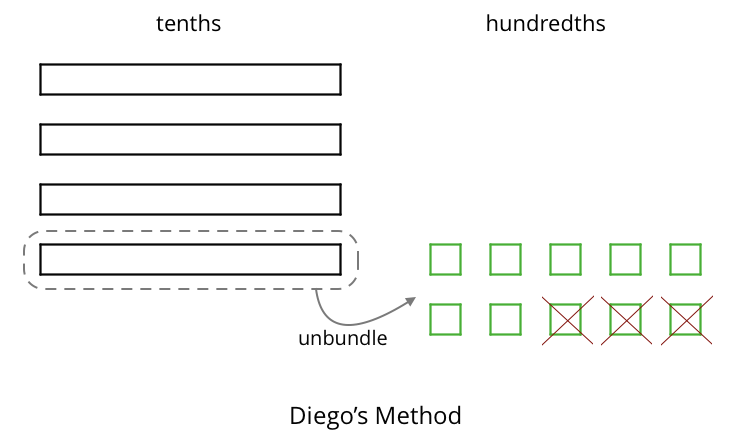
-
Noah started by drawing 4 rectangles to represent 0.4. He then crossed out 3 of rectangles to represent the subtraction, leaving 1 rectangle in his diagram.
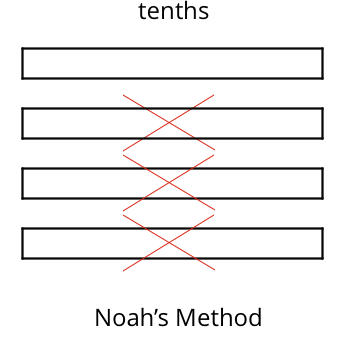
-
Do you agree that either diagram correctly represents \(0.4 - 0.03\)? Discuss your reasoning with a partner.
-
To represent \(0.4 - 0.03\), Elena drew another diagram. She also started by drawing 4 rectangles. She then replaced all 4 rectangles with 40 squares and crossed out 3 squares to represent subtraction of 0.03, leaving 37 squares in her diagram. Is her diagram correct? Discuss your reasoning with a partner.
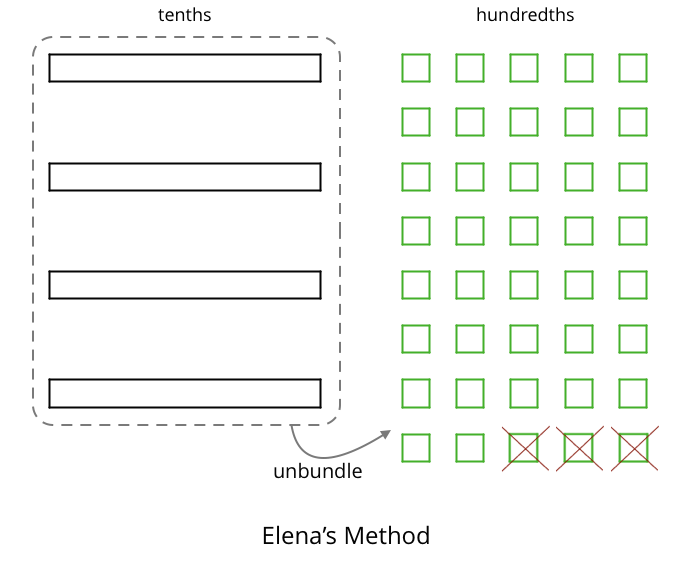
- Find each difference. If you get stuck, you can use the applet to represent each expression and find its value.
- \(0.3 - 0.05\)
- \(2.1 - 0.4\)
- \(1.03 - 0.06\)
- \(0.02 - 0.007\)
Be prepared to explain your reasoning.
- The applet has tools that create each of the base-ten blocks. This time you need to decide the value of each block before you begin.
- Select a Block tool, and then click on the screen to place it.
- Click on the Move tool (the arrow) when you are done choosing blocks.
- Subtract by deleting with the delete tool (the trash can), not by crossing out.
A distant, magical land uses jewels for their bartering system. The jewels are valued and ranked in order of their rarity. Each jewel is worth 3 times the jewel immediately below it in the ranking. The ranking is red, orange, yellow, green, blue, indigo, and violet. So a red jewel is worth 3 orange jewels, a green jewel is worth 3 blue jewels, and so on.
At the Auld Shoppe, a shopper buys items that are worth 2 yellow jewels, 2 green jewels, 2 blue jewels, and 1 indigo jewel. If they came into the store with 1 red jewel, 1 yellow jewel, 2 green jewels, 1 blue jewel, and 2 violet jewels, what jewels do they leave with? Assume the shopkeeper gives them their change using as few jewels as possible.
Summary
Base-ten diagrams represent collections of base-ten units—tens, ones, tenths, hundredths, etc. We can use them to help us understand sums of decimals.
Suppose we are finding \(0.08 + 0.13\). Here is a diagram where a square represents 0.01 and a rectangle (made up of ten squares) represents 0.1.
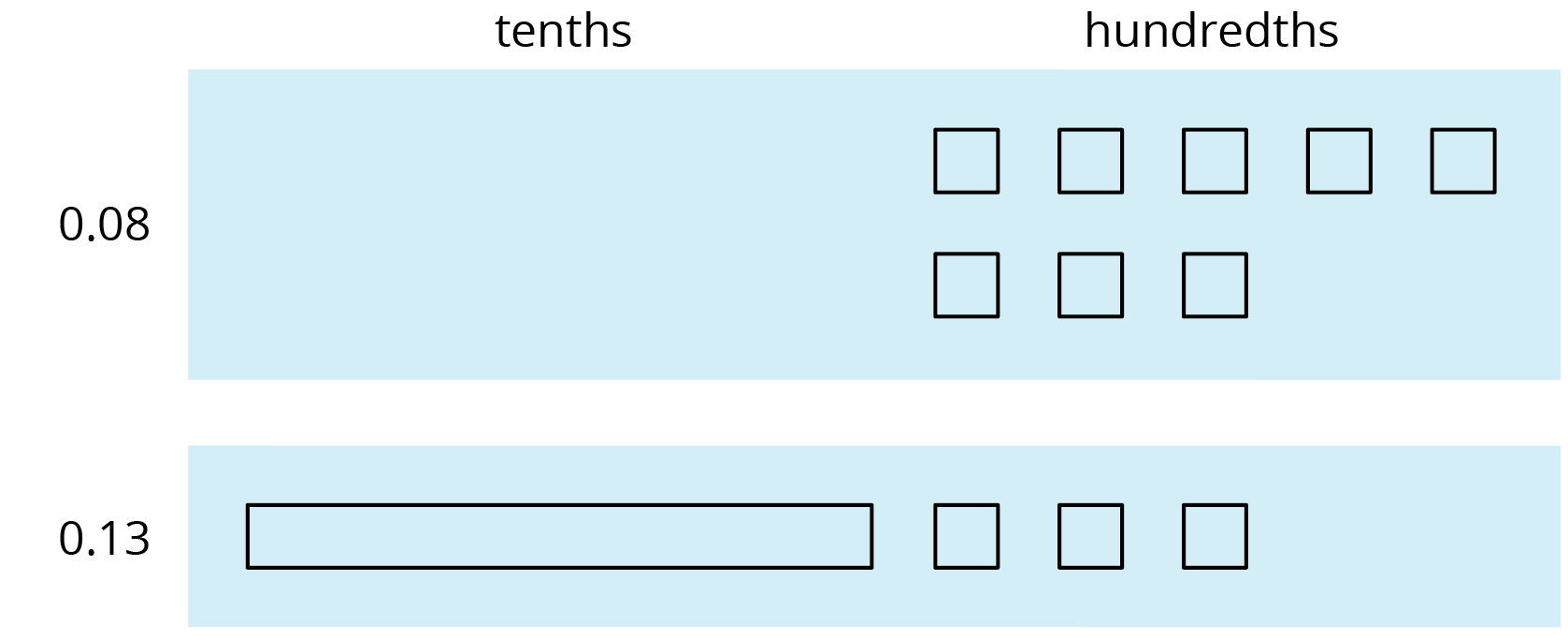
To find the sum, we can “bundle” (or compose) 10 hundredths as 1 tenth.
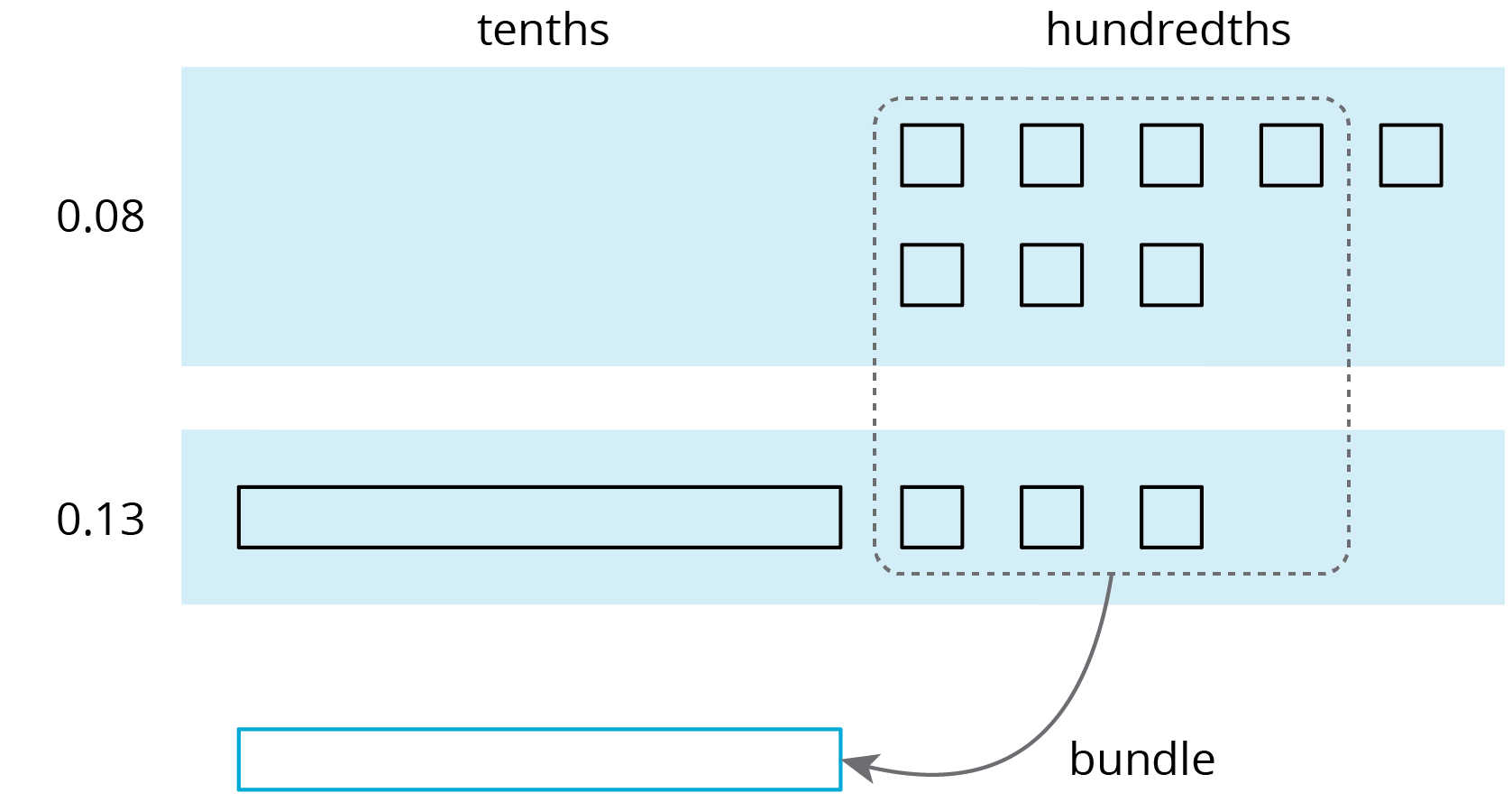
We now have 2 tenths and 1 hundredth, so \(0.08 + 0.13 = 0.21\).

We can also use vertical calculation to find \(0.08 + 0.13\).
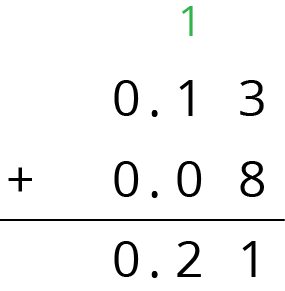
Notice how this representation also shows 10 hundredths are bundled (or composed) as 1 tenth.
This works for any decimal place. Suppose we are finding \(0.008 + 0.013\). Here is a diagram where a small rectangle represents 0.001.
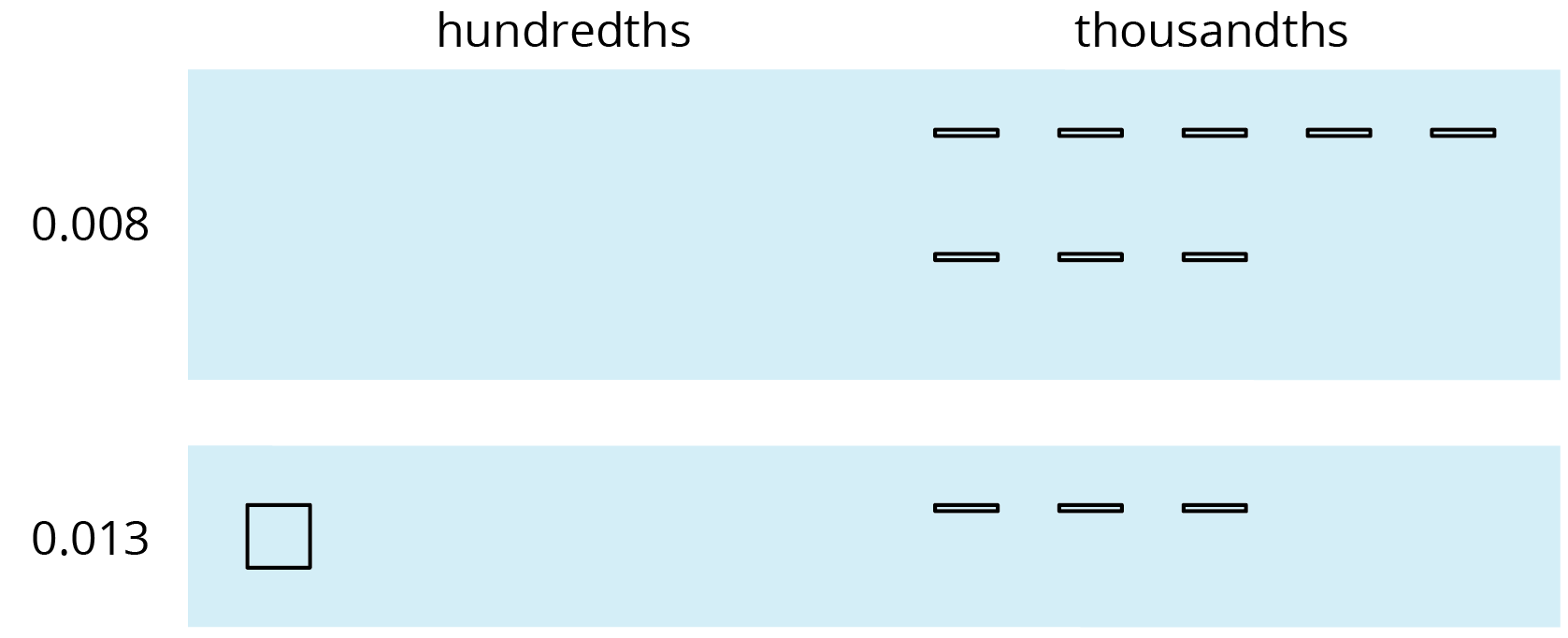
We can “bundle” (or compose) 10 thousandths as 1 hundredth.
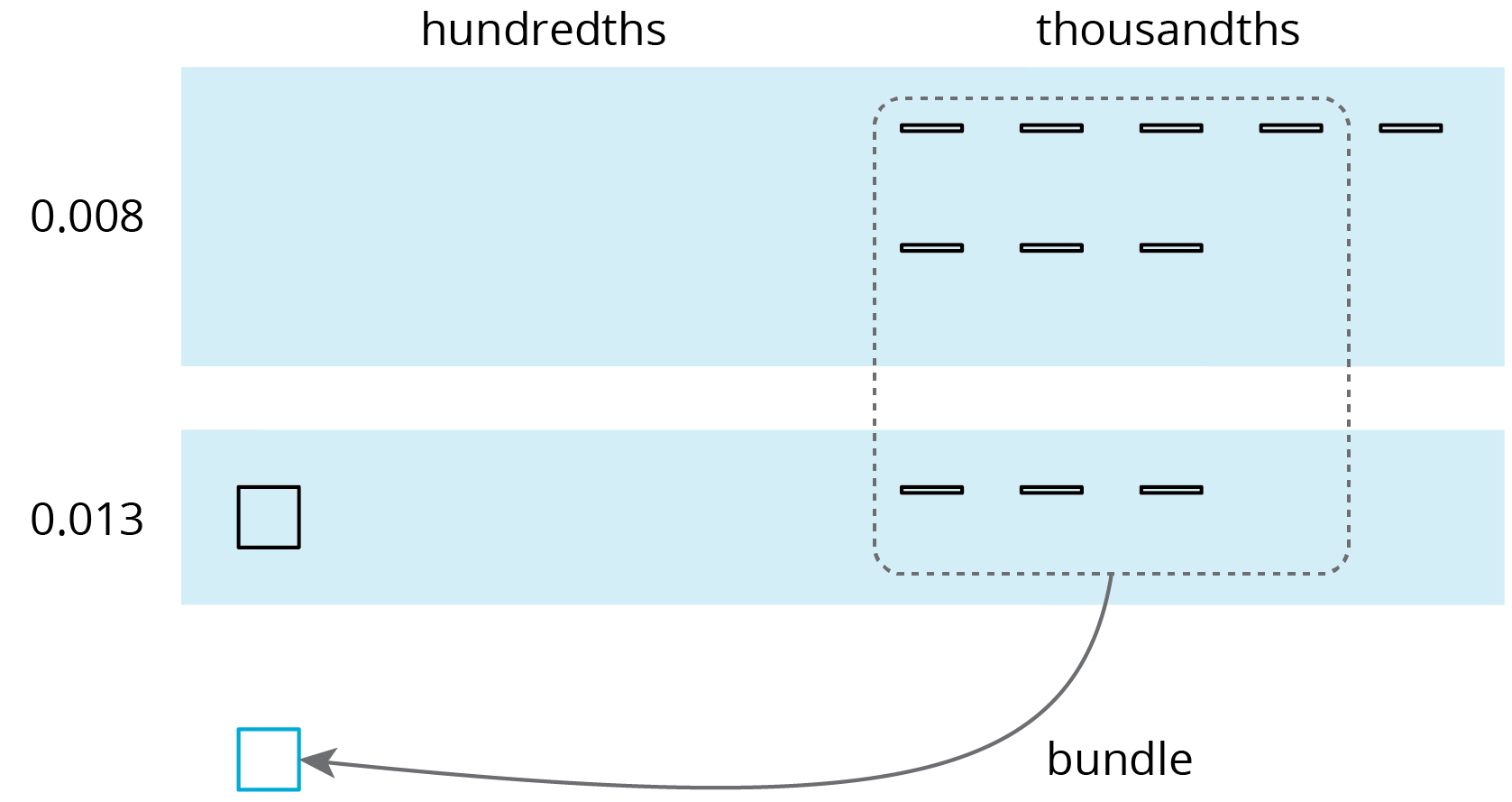
The sum is 2 hundredths and 1 thousandth.

Here is a vertical calculation of \(0.008 + 0.013\).
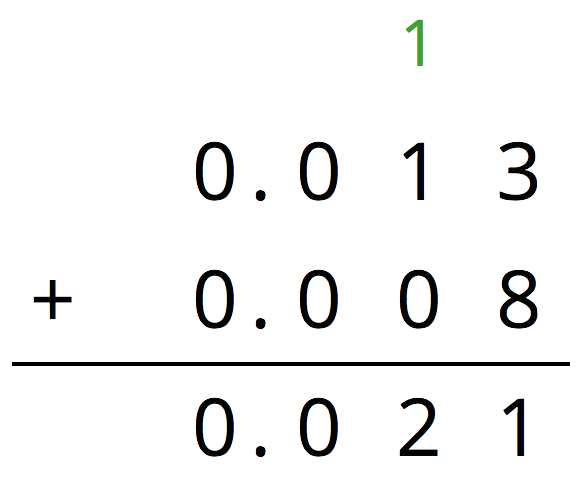
Base-ten diagrams can help us understand subtraction as well. Suppose we are finding \(0.23 - 0.07\). Here is a diagram showing 0.23, or 2 tenths and 3 hundredths.

Subtracting 7 hundredths means removing 7 small squares, but we do not have enough to remove. Because 1 tenth is equal to 10 hundredths, we can “unbundle” (or decompose) one of the tenths (1 rectangle) into 10 hundredths (10 small squares).

We now have 1 tenth and 13 hundredths, from which we can remove 7 hundredths.

We have 1 tenth and 6 hundredths remaining, so \(0.23 - 0.07 = 0.16\).

Here is a vertical calculation of \(0.23 - 0.07\).

Notice how this representation also shows a tenth is unbundled (or decomposed) into 10 hundredths in order to subtract 7 hundredths.
This works for any decimal place. Suppose we are finding \(0.023 - 0.007\). Here is a diagram showing 0.023.

We want to remove 7 thousandths (7 small rectangles). We can “unbundle” (or decompose) one of the hundredths into 10 thousandths.

Now we can remove 7 thousandths.

We have 1 hundredth and 6 thousandths remaining, so \(0.023 - 0.007 = 0.016\).

Here is a vertical calculation of \(0.023 - 0.007\).
